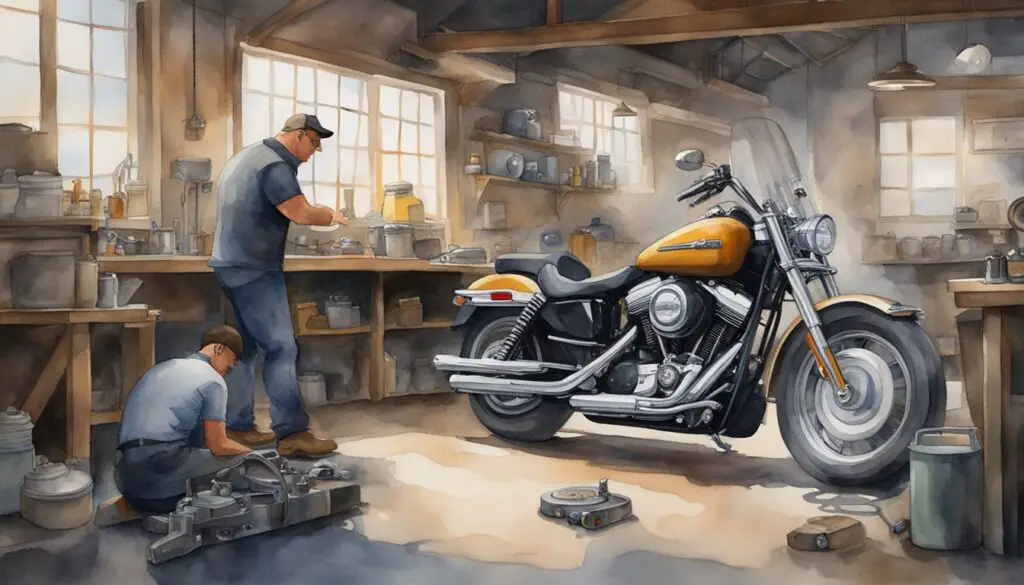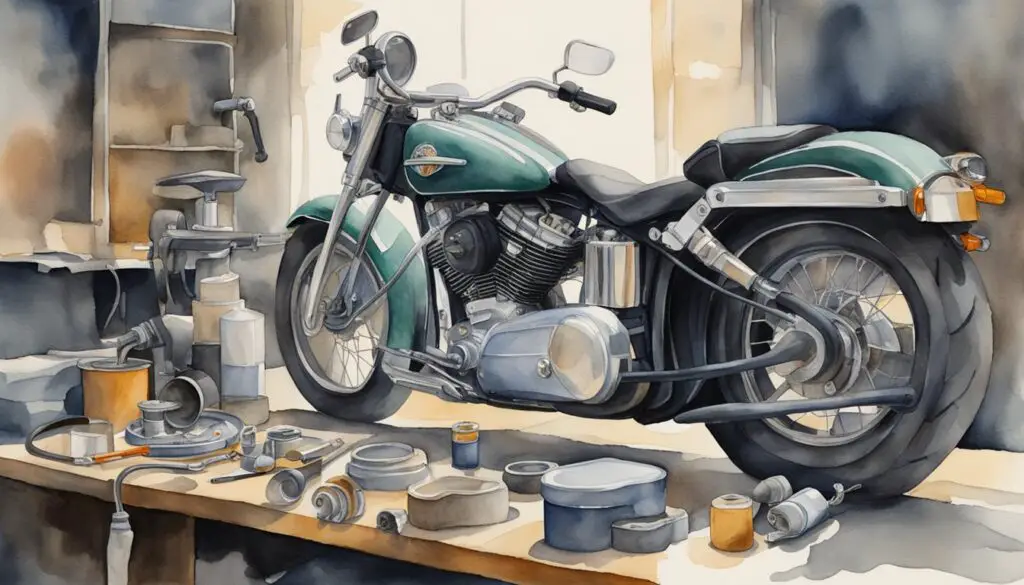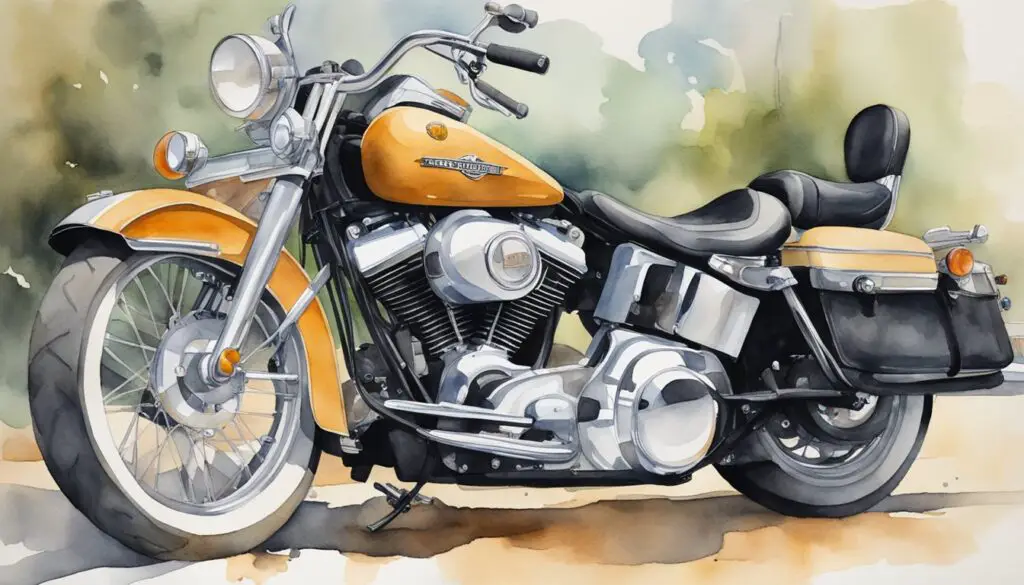If you own a Harley Davidson motorcycle, you know that a faulty starter can be a frustrating issue. When you turn the key, and the engine doesn’t start, it can be discouraging. However, before you take your bike to the shop, there are a few simple troubleshooting steps that you can take to diagnose and fix the problem.

Understanding the basics of Harley Davidson starters is the first step in troubleshooting. The starter system of a Harley Davidson motorcycle consists of several components, including the battery, starter motor, starter solenoid, and starter relay. Each of these components must be in good working order for the starter to function correctly. If any of these parts fail, it can cause the starter to malfunction.
Initial troubleshooting steps involve checking the battery, fuses, and connections. A dead battery is one of the most common causes of starter problems. If the battery is fully charged, the fuses are good, and the connections are tight, the problem may be with the starter motor, starter solenoid, or starter relay. In this case, more advanced diagnostic procedures may be necessary.
Key Takeaways
- Understanding the basics of Harley Davidson starters is essential for troubleshooting.
- Initial troubleshooting steps involve checking the battery, fuses, and connections.
- Advanced diagnostic procedures may be necessary if the problem is with the starter motor, starter solenoid, or starter relay.
Understanding the Basics of Harley Davidson Starters
If you’re experiencing problems with your Harley Davidson starter, then it’s important to understand the basics of the starter system. This will help you diagnose and fix any issues you may be having.
Components of the Starter System
The starter system on a Harley Davidson consists of several components that work together to turn the engine over. These components include:
- Starter motor: This is the main component of the starter system. It’s responsible for turning the engine over when you press the starter button.
- Starter relay: The starter relay is a small electrical component that sends power to the starter motor when you press the starter button.
- Battery: The battery provides the power needed to turn the engine over.
- Starter solenoid: The starter solenoid is responsible for engaging the starter motor with the engine’s flywheel.
Common Symptoms of Starter Problems
If you’re experiencing problems with your Harley Davidson starter, then you may notice one or more of the following symptoms:
- Clicking sound when you press the starter button: This could be a sign that there’s a problem with the starter relay or starter motor.
- Engine won’t turn over: If you press the starter button and the engine won’t turn over, then there could be a problem with the starter motor, battery, or starter solenoid.
- Slow cranking: If the engine is turning over slowly, then this could be a sign that the battery is low or there’s a problem with the starter motor.
By understanding the basics of the Harley Davidson starter system and the common symptoms of starter problems, you’ll be better equipped to diagnose and fix any issues you may be having.
Initial Troubleshooting Steps
If you are experiencing issues with your Harley Davidson starter, there are a few initial troubleshooting steps you can take to identify the problem. Before you start, make sure you have the necessary tools, including a multimeter and a service manual.
Inspecting the Battery Condition
The first step is to inspect the battery condition. A weak or dead battery can cause starter problems. Check the battery terminals for any signs of corrosion or loose connections. If you notice any corrosion, clean the terminals with a wire brush and apply a thin layer of dielectric grease to prevent future corrosion. Use a multimeter to test the battery voltage. A fully charged battery should read around 12.6 volts. If the voltage is low, recharge or replace the battery.
Checking the Starter Relay
The starter relay is responsible for sending power to the starter motor. If the relay is faulty, the starter motor won’t receive power, resulting in starter problems. Check the starter relay for any signs of damage or corrosion. Use a multimeter to test the continuity of the relay. If the relay is faulty, replace it with a new one.
Evaluating Wiring and Electrical Connections
Wiring and electrical connections play a critical role in the starter system. Check all wiring and connections for any signs of damage or corrosion. Use a multimeter to test the continuity of the wiring. If you notice any issues, repair or replace the wiring or connections as necessary.
By following these initial troubleshooting steps, you can identify and fix most Harley Davidson starter problems. If the issue persists, refer to the service manual or seek professional assistance.
Diagnosing Starting Issues

If you’re having trouble starting your Harley Davidson, there are a few things you can do to diagnose the problem. Before you start, make sure your battery is fully charged and your fuel tank is full. Then, follow these steps:
Intermittent Starting Problems
If your bike is starting intermittently, it could be due to a number of issues. One common cause is a loose or corroded connection in the starter circuit. Check all the connections and make sure they are tight and clean. Another possible cause is a faulty starter relay. You can test this by using a multimeter to check the resistance across the relay contacts.
Identifying Grinding or Clicking Noises
If you hear a grinding or clicking noise when you try to start your bike, it could be due to a problem with the starter motor or the starter clutch. Check the starter motor for signs of wear or damage, and make sure it is spinning freely. If the starter motor is fine, the problem may be with the starter clutch. This is a more complicated repair and may require the help of a professional mechanic.
Testing the Ignition Switch and Start Button
If your bike isn’t starting at all, it could be due to a problem with the ignition switch or start button. Check the ignition switch for signs of wear or damage, and make sure it is functioning properly. You can test the start button by using a multimeter to check the resistance across the contacts when the button is pressed.
Remember, troubleshooting starting issues can be a complicated process, and it may take some time to diagnose the problem. If you’re unsure about any of the steps, or if you’re not comfortable working on your bike, it’s always best to seek the help of a professional mechanic.
Advanced Diagnostic Procedures

If you’re still having trouble with your Harley Davidson starter, there are some advanced diagnostic procedures you can perform to pinpoint the issue.
Using a Service Manual for In-Depth Troubleshooting
One of the most important tools you can have when diagnosing starter problems is a service manual. This will provide you with detailed information on your motorcycle’s electrical system, as well as step-by-step instructions for troubleshooting and repair. Be sure to consult your service manual before attempting any advanced diagnostic procedures.
Performing Voltage Drop Tests
Voltage drop tests can help you determine whether there is excessive resistance in the starter circuit. To perform this test, you’ll need a multimeter. First, connect the multimeter to the battery terminals and record the voltage. Then, connect the multimeter to the starter motor terminal and the starter solenoid terminal. Crank the engine and record the voltage readings. If the voltage drop is greater than 0.5 volts, there may be an electrical problem in the starter circuit.
Checking the Starter Solenoid and Motor
If you’ve ruled out other potential causes of starter problems, it may be time to check the starter solenoid and motor. To do this, you’ll need to remove the starter from your motorcycle and perform a bench test. Connect the starter to a fully charged battery using jumper cables. If the starter spins freely and produces a healthy spark, it’s likely that the issue lies elsewhere in the starter circuit. If the starter fails this test, you may need to replace it.
By using these advanced diagnostic procedures, you’ll be able to identify and resolve starter problems on your Harley Davidson motorcycle. Remember to always consult your service manual and exercise caution when working with electrical systems.
Repair and Replacement Solutions

If you’re experiencing issues with your Harley Davidson starter, you may need to consider repair or replacement options. In this section, we’ll go over when to repair vs. replace the starter, a step-by-step starter replacement guide, and upgrading the starter system.
When to Repair vs. Replace the Starter
If you’re experiencing minor issues with your starter, such as a clicking sound or slow cranking, it may be possible to repair the starter. However, if your starter is completely dead or has major issues, replacement may be necessary.
When deciding whether to repair or replace your starter, consider the cost. In some cases, it may be more cost-effective to replace the starter rather than repair it. Additionally, if your starter is old and has already been repaired multiple times, replacement may be the better option.
Step-by-Step Starter Replacement Guide
If you’ve decided to replace your starter, here’s a step-by-step guide to help you through the process:
- Disconnect the battery cables.
- Remove the primary cover and drain the primary oil.
- Remove the starter bolts and disconnect the starter wires.
- Install the new starter and connect the wires.
- Replace the primary cover and fill with oil.
- Reconnect the battery cables.
It’s important to follow the manufacturer’s instructions and use the correct tools to avoid damaging any components during the replacement process.
Upgrading the Starter System
If you’re looking to upgrade your starter system, there are a few options available. Upgrading to a high-torque starter can provide better performance and reliability. Additionally, upgrading to a lithium-ion battery can reduce weight and improve starting power.
When upgrading your starter system, be sure to research the options and choose components that are compatible with your Harley Davidson model.
In conclusion, repairing or replacing your Harley Davidson starter can be a daunting task, but with the right knowledge and tools, it can be done successfully. Remember to consider the cost and choose components that are compatible with your bike.
Preventative Maintenance and Care

When it comes to maintaining your Harley Davidson motorcycle, preventative care is key to avoiding starter system problems. Regular inspection and maintenance tips, using a battery tender for optimal performance, and ensuring longevity of the starting system are all important steps in keeping your ride in top condition.
Regular Inspection and Maintenance Tips
Inspecting your motorcycle regularly is the best way to prevent starter system problems. Check your battery connections for signs of corrosion and ensure that your battery is properly charged. Inspect the wiring for signs of wear or damage and clean and tighten connections as needed. Additionally, check your spark plugs and fuel injectors to ensure they are in good condition.
Using a Battery Tender for Optimal Performance
A battery tender is an essential tool for maintaining the performance of your Harley Davidson motorcycle’s battery. It will keep your battery charged and ready to go, even if you haven’t ridden your bike for an extended period. Simply connect the battery tender to your bike’s battery and plug it in. The battery tender will automatically monitor and maintain the optimal charge level for your battery.
Ensuring Longevity of the Starting System
To ensure the longevity of your Harley Davidson motorcycle’s starting system, it’s important to follow a few simple steps. First, avoid leaving the battery in a discharged state for extended periods. Second, make sure to use a high-quality battery that is designed for your specific model of motorcycle. Third, regularly inspect and maintain your starter motor and starter relay to ensure they are functioning properly.
By following these simple tips, you can help prevent starter system problems and keep your Harley Davidson motorcycle in top condition. With proper maintenance and care, your ride will provide you with years of reliable service.
Additional Considerations for Troubleshooting

When it comes to troubleshooting Harley Davidson starter problems, there are a few additional considerations that you should keep in mind. In this section, we’ll discuss some of the most important factors that can affect your bike’s ability to start and what you can do to address them.
Dealing with Electrical Issues Beyond the Starter
While the starter is often the primary culprit when a Harley won’t start, there are a number of other electrical issues that can also cause problems. For example, a weak battery, corroded connections, or a faulty ignition switch can all prevent your bike from starting up properly.
To diagnose these kinds of issues, you’ll need to use a multimeter to test various components of your bike’s electrical system. Make sure to consult your service manual or a qualified mechanic for guidance on how to perform these tests safely and accurately.
Understanding the Role of the Fuel System in Starting
In addition to electrical issues, problems with your bike’s fuel system can also prevent it from starting. For example, a clogged fuel filter, a weak fuel pump, or low fuel pressure can all cause starting problems.
To diagnose these kinds of issues, you may need to test your bike’s fuel pressure using a fuel pressure gauge. Again, consult your service manual or a qualified mechanic for guidance on how to perform these tests safely and accurately.
Tips for Non-Start Situations
Finally, it’s important to remember that sometimes your bike won’t start simply because of user error. For example, forgetting to turn on the ignition switch, leaving the kill switch engaged, or not putting the bike in neutral can all prevent it from starting up.
If you’re experiencing non-start situations, make sure to double-check all of the basic safety and operational requirements before moving on to more complex troubleshooting steps. This can save you a lot of time and frustration in the long run.
By keeping these additional considerations in mind, you’ll be better equipped to diagnose and fix any Harley Davidson starter problems that come your way. Remember to always prioritize safety and consult a qualified mechanic if you’re unsure about any aspect of the troubleshooting process.
Frequently Asked Questions
What are common signs that indicate a starter issue on a Harley Davidson?
There are several signs that can indicate a starter issue on a Harley Davidson. One of the most common signs is a clicking noise when you try to start your motorcycle. Other signs include slow cranking or no cranking at all, a grinding noise, or a burning smell coming from the starter motor. If you notice any of these signs, it’s important to troubleshoot the issue as soon as possible to avoid further damage to your motorcycle.
How can I troubleshoot a clicking noise when trying to start my Harley Davidson?
If you hear a clicking noise when trying to start your Harley Davidson, it could be due to a number of issues. One common cause is a weak battery, which may not have enough power to turn the starter motor. To troubleshoot this issue, you can try jump-starting your motorcycle or charging the battery. Another possible cause is a faulty starter solenoid, which may need to be replaced. You can also check the electrical connections to make sure they are clean and tight.
What steps should I take if there’s no power to my Harley Davidson’s starter?
If there’s no power to your Harley Davidson’s starter, the first thing you should do is check the battery. Make sure it’s fully charged and that the terminals are clean and tight. If the battery is fine, you can check the starter relay and the starter solenoid to make sure they are working properly. You can also check the wiring and fuses to make sure there are no issues there.
Where is the starter solenoid located on a Harley Davidson motorcycle?
The starter solenoid on a Harley Davidson motorcycle is typically located near the battery or the starter motor. On some models, it may be located under the seat or behind the side cover. You can consult your owner’s manual or a service manual to find the exact location on your specific model.
How can I identify a faulty starter solenoid on my Harley Davidson?
A faulty starter solenoid on a Harley Davidson can cause a number of issues, including a clicking noise when trying to start the motorcycle, slow cranking, or no cranking at all. To identify a faulty solenoid, you can use a multimeter to test the voltage at the solenoid terminals. If there is no voltage or the voltage is low, the solenoid may be faulty and need to be replaced.
What should I check if my Harley Davidson won’t start despite a good battery?
If your Harley Davidson won’t start despite having a good battery, there may be several issues at play. One common cause is a faulty starter motor, which may need to be replaced. You can also check the starter relay, the starter solenoid, and the wiring to make sure there are no issues there. Additionally, you can check the spark plugs and fuel system to make sure they are functioning properly. If you’re not sure what the issue is, it’s best to consult a professional mechanic.
Last updated on May 7, 2024
